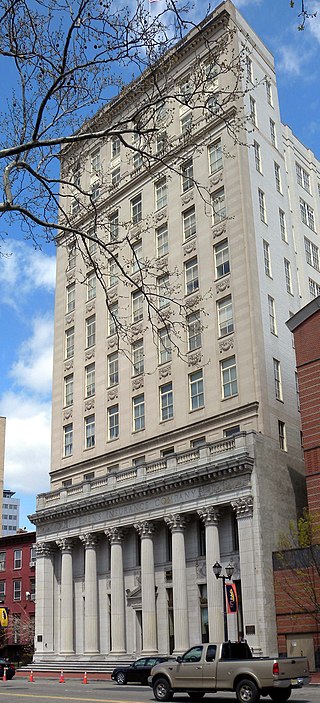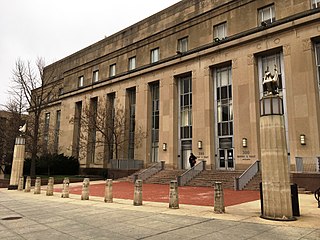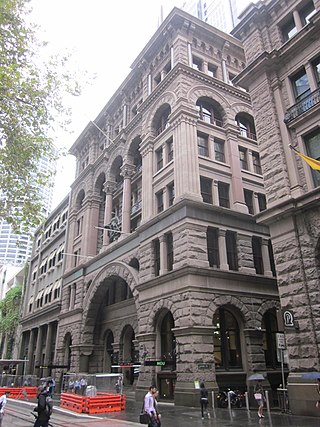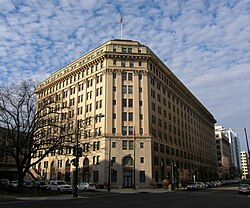
Branch House in Richmond, Virginia, was designed in 1916 by the firm of John Russell Pope as a private residence of financier John Kerr Branch (1865–1930) and his wife Beulah Gould Branch (1860–1952).

Dollar Bank is a full-service regional savings bank serving both individuals and business customers, operating more than 90 offices throughout Pennsylvania, Ohio, Maryland, and Virginia. The bank's Pennsylvania headquarters is located in downtown Pittsburgh, Ohio headquarters is located in downtown Cleveland, and Virginia headquarters is located in Hampton Roads.

The Woodward & Lothrop Service Warehouse is a historic warehouse located in the NoMa neighborhood of Washington, D.C. It was designated a District of Columbia Historic Landmark in 1993, and was added to the National Register of Historic Places in 2005. The building is visible from the NoMa–Gallaudet U Metro station.

Thackeray Hall is an academic building of the University of Pittsburgh and a contributing property to the Schenley Farms National Historic District at 139 University Place on the campus of the University of Pittsburgh in Pittsburgh, Pennsylvania, United States.

The Greenbelt Historic District is a national historic district located in Greenbelt, Prince George's County, Maryland, United States. The district preserves the center of one of the few examples of the Garden city movement in the United States. With its sister cities of Greenhills, Ohio and Greendale, Wisconsin, Greenbelt was intended to be a "new town" that would start with a clean slate to do away with problems of urbanism in favor of a suburban ideal. Along with the never-commenced town of Greenbrook, New Jersey, the new towns were part of the New Deal public works programs.
Paul Amos Batholomew (1883–1973) was an architect in Greensburg, Pennsylvania. From the beginning of his practice, he received a variety of high-profile commissions for both residential and non-residential structures, mainly in Westmoreland County, Pennsylvania. His buildings typically had historicist facades, with neoclassical or Italianate ornamentation covering a modern framework. It was only in the 1950s, toward the end of his career, that he created buildings that were purely modern in design. During the Great Depression, a particularly trying time for architects, he received the commission to design Norvelt, which was a new town created as part of President Roosevelt's New Deal policies.

The Lafayette Building, also known as Export-Import Bank Building, is a federal government office building at 811 Vermont Avenue NW in Washington, D.C. Completed in 1940, it was declared a National Historic Landmark in 2005. Its landmark designation was made because it was home to the Reconstruction Finance Corporation, the government arm that financed and oversaw the mobilization of the United States economy during World War II. It is currently home to the Export–Import Bank of the United States and to offices of the United States Department of Veterans Affairs.

The Home Office Building is located adjacent to Military Park at 10 Park Place in Newark, Essex County, New Jersey, United States. The building was built in 1928 and was added to the National Register of Historic Places on June 17, 1982.

James G. Hill (1841–1913) was an American architect who, during the period 1876 to 1883, headed the Office of the Supervising Architect of the United States Department of the Treasury, which oversaw major Federal buildings.

The Old Federal Reserve Bank Building is an historic, American bank building that is located at 925 Chestnut Street, on the corner of South 10th Street, in the Market East neighborhood of Philadelphia, Pennsylvania.

The Hamilton Hotel is a AAA 4-diamond hotel in downtown Washington, D.C., United States, located at 1001 14th Street, N.W., just to the north of Franklin Square. It is a member of Historic Hotels of America, the official program of the National Trust for Historic Preservation.

Appleton Prentiss Clark Jr. was an American architect from Washington, D.C. During his 60-year career, Clark was responsible for designing hundreds of buildings in the Washington area, including homes, hotels, churches, apartments and commercial properties. He is considered one of the city's most prominent and influential architects from the late 19th and early 20th centuries. Many of his designs are now listed on the National Register of Historic Places (NRHP).

The architecture of Jacksonville is a combination of historic and modern styles reflecting the city's early position as a regional center of business. According to the National Trust for Historic Preservation, there are more buildings built before 1967 in Jacksonville than any other city in Florida, though few structures in the city center predate the Great Fire of 1901. Numerous buildings in the city have held state height records, dating as far back as 1902, and last holding a record in 1981.

The Henry J. Daly Building is located at 300 Indiana Avenue, NW, and 301 C Street, NW, in the Judiciary Square neighborhood of Washington, D.C., United States. The administrative building is owned by the government of the District of Columbia and has served as the home of various city offices since it opened in 1941 as a unified location for previously dispersed municipal functions. Currently, the building is primarily occupied by the Metropolitan Police Department; although the District of Columbia Department of Corrections, the District of Columbia Office of the Chief Financial Officer and the Court Services and Offender Supervision Agency (CSOSA) also maintain offices in the building.

Albert L. Harris was an American architect who worked primarily in Washington, D.C. He was born in Wales and emigrated to the United States as a young child. He worked for architectural firms in Chicago and Baltimore and then Washington, where he also obtained an architectural degree from George Washington University. He was a part-time professor there while also working for the US Navy and then the city of Washington where he served as the city's Municipal Architect from 1921 until his death in 1933. A number of his works are listed on the National Register of Historic Places (NRHP).

The MLC Building is a heritage-listed office building located at 42–46 Martin Place in the Sydney central business district, in the City of Sydney local government area of New South Wales, Australia. It was designed by Bates Smart & McCutcheon and built from 1936 to 1938 by Concrete Constructions Limited. It is also known as Mutual Life & Assurance Building. It was added to the New South Wales State Heritage Register on 2 April 1999. From the time of its construction and for many years thereafter, the building served as the offices for Australian life insurance company, Mutual Life & Citizens Assurance Company Limited. As of December 2018 the anchor tenant was Norton Rose Fulbright, formerly Henry Davis York, an international law firm.

348–352 George Street, Sydney is a heritage-listed office building located at 348–352 George Street, in the Sydney central business district, in the City of Sydney local government area of New South Wales, Australia. It was designed by Edward Raht and built by Hudson and Loveridge. It is also known as the National Mutual Building (former), Society General Building, Societe Generale House, Equitable Building and 350 George Street, Sydney. The property is privately owned and was added to the New South Wales State Heritage Register on 2 April 1999.

Robert O. Scholz (1895–1978) was an American architect from Washington, D.C., who is considered one of the city's most important Art Deco designers. A native of New York City, his German parents later moved to Chicago, where he studied at the Armour Institute. Scholz briefly served during World War I before moving to Washington, D.C. He worked as an engineer and draftsman before starting his own architectural firm in 1922.

The Mutual Savings Bank Building, is a building located at 700 Market Street at the corner of Kearny, Market, and Geary Streets in the Financial District in San Francisco, California. It was built in 1902 and was designed by architect, William F. Curlett in the French Renaissance Revival style. The 12-story building was one of San Francisco earliest skyscrapers. The building was added to the National Register of Historic Places on January 22, 2014.

The Freedman's Bank Building, previously known as the Treasury Annex, is a historic office building located on the corner of Madison Place and Pennsylvania Avenue NW in Washington, D.C. It sits on the east side of Lafayette Square, a public park on the north side of the White House, and across from the Treasury Building. The adjoining properties include the Howard T. Markey National Courts Building to the north and the former Riggs National Bank to the east.




















